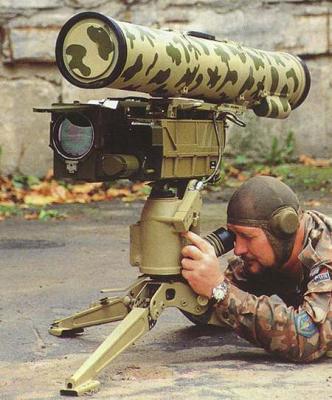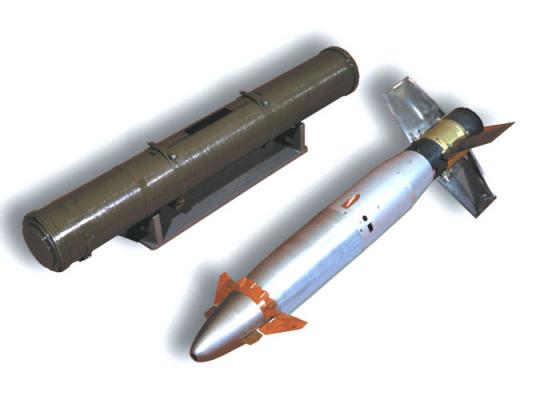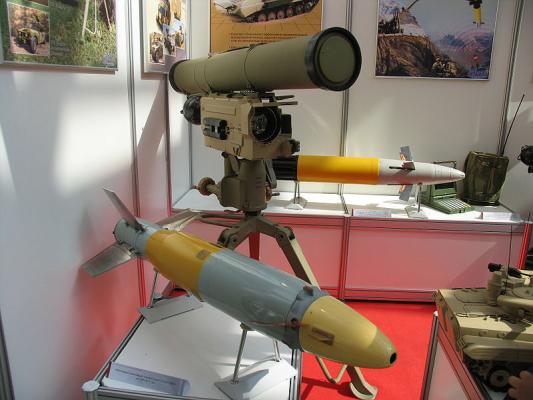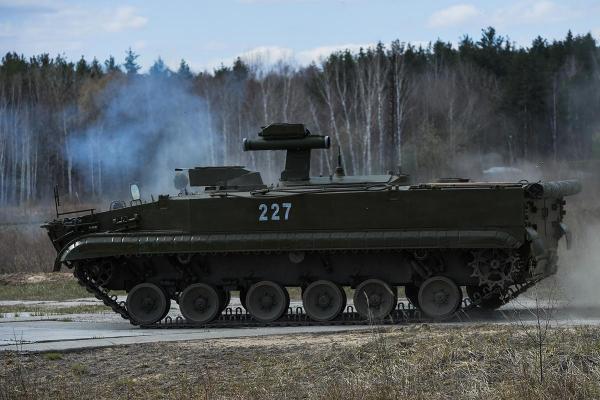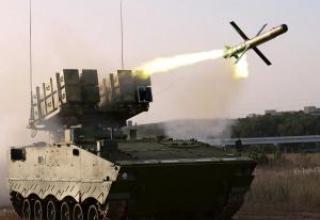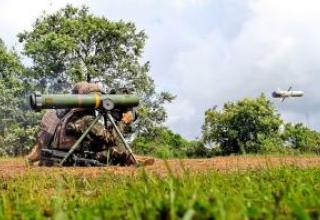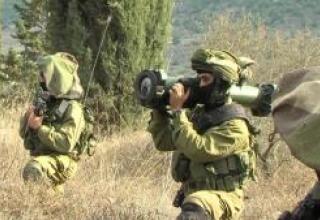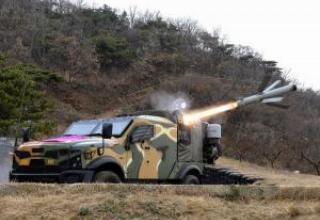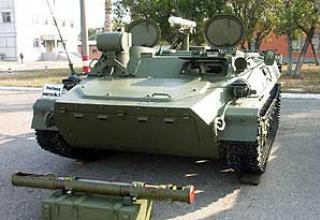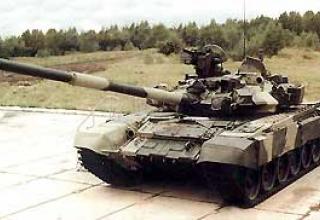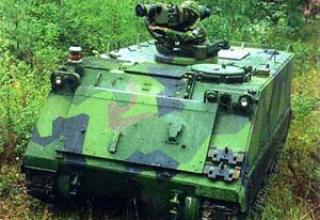The second class "Kornet" airborne anti-tank missile system is designed to engage modern and advanced armored vehicles equipped with dynamic protection, fortifications, enemy manpower, low-speed air and surface targets at any time of day, in difficult weather conditions, in the presence of passive and active optical interference.
The "Kornet" complex was developed in the Instrumentation Design Bureau, Tula.
The complex can be placed on any media, including those with an automated warhead, thanks to the low weight of the remote launcher it can be used independently in a portable version. In terms of its tactical and technical characteristics, the Kornet complex fully meets the requirements for the system of modern multi-purpose defensive and assault weapons, and allows to quickly solve tactical tasks in the area of responsibility of ground forces units, tactical depth to the enemy of 6 km. The originality of the design solutions of this complex, its high manufacturability, efficiency of combat application, simplicity and reliability in operation contributed to its wide spread abroad.
The export version of the Kornet-E complex was first presented in 1994 at the exhibition in Nizhny Novgorod.
In the west, the complex was designated AT-14 .
Composition:
The complex consists of:
- Guided missiles 9M133-1 (see diagram) with tandem-cumulative and thermobaric warheads;
- launchers: the portable 9P163M-1 (see image) and the multi-charger, lightweight (see combined image);
- thermal imaging sight;
- maintenance facilities;
- training aids.
The 9M133 rocket (see Photo 1, Photo 2) is made according to the aerodynamic scheme "duck" with two rudders opening from niches forward on the flight. In the front part of the missile body is placed the leading charge of the tandem BC and elements of the air-dynamic drive of the semi-open circuit with the frontal air intake. Further, in the middle section of the rocket is placed solid fuel jet engine with air intake channels and with the tail of two nozzles. Behind the RDTT is the main cumulative combat unit. The tail unit is equipped with control system elements, including a laser light photoreceiver. Four folding wings made of thin sheets of steel that open after launch under the action of their own elastic forces are placed on the tail compartment body and are located at an angle of 45° relative to the rudders. PTUR and embroidery motor unit are placed in an airtight plastic TPK with hinged covers and handle. Storage time in TPK without inspection - up to 10 years.
The powerful PTUR 9M133-1 tandem cumulative combat unit is capable of engaging all modern and advanced enemy tanks, including those equipped with mounted or built-in dynamic protection, as well as piercing concrete monoliths and structures made of precast concrete with the thickness of 3 - 3.5 m. A distinctive feature of the layout of PTUR 9M133-1 is the location of the marching engine between the leading and main cumulative charges, which, on the one hand, protects the main charge from fragments of the leading, increases the focal length and, as a consequence, increases the armor penetration, and on the other hand - allows you to have a powerful leading charge that provides overcoming the mounted and built-in dynamic protection. which provides reliable overcoming of hinged and built-in dynamic protection. The probability of destruction of such tanks as M1A2 Abrams, Leclerc, Challenger-2, Leopard-2A5, Merkava Mk.3B by missile of 9M133 complexes "Kornet-P/T" at an angle of fire of ±90°, is on average 0.70 - 0.80, i.e. the cost of destruction of each tank is one - two missiles. In addition, the tandem cumulative BC is capable of penetrating concrete monoliths and precast concrete structures with a minimum thickness of 3-3.5 m. And the high pressure level that develops when the cumulative BC collides with the target, both axially and radially, leads to crushing the concrete in the areas of the cumulative jet, breaking the rear layer of the barrier and, as a consequence, a high barrier effect.
For complex "Kornet" created rocket 9M133F (9M133F-1) with thermobaric warhead of blast action, on the mass-dimensioning characteristics of a completely identical rocket with a cumulative BC. Thermobaric BC has a large blast radius and high temperature of the explosion products. An explosion of such a BC generates a longer blast wave in space and time than a conventional explosive. Such a wave is caused by the sequential involvement in the process of detonation transformation of air oxygen, it penetrates into obstacles, trenches, through embrasures, etc., affecting the live force, including protected. In the zone of detonation transformations of thermobaric mixture there is almost complete combustion of oxygen and the temperature develops 800 - 850 ° C. Thermobaric warhead of missile 9M133F (9M133F-1) with TNT equivalent of 10 kg, in its blast and ignition effect on the target is not inferior to the BC standard 152 mm OFS. The necessity of such BC on high-precision weapon is confirmed by experience of local conflicts. The Kornet APC, due to the PTUR 9M133F (9M113F-1), has become a powerful assault weapon, which is capable of effectively destroying fortifications (bunkers, dots, zots) in the city limits, in the mountains and in the field, as well as of engaging enemy firepower, placed in residential and commercial buildings and structures, behind their fragments, in the folds of the terrain, trenches and premises, as well as to destroy these objects, vehicles and armored vehicles, causing fires in them and in open terrain, in the presence of flammable materials.
Portable version of PTRK "Kornet-E" is placed on the PU 9P163M-1, consisting of a tripod machine with high-precision mechanical drives, sight-detector guidance 1P45M-1 and a rocket launcher. The sight-guiding device is periscopic: the device itself is installed in a container under the cradle of PU, the rotating eyepiece is at the bottom left. PTUR is installed on the cradle on top of the PU, after firing it is replaced manually. The height of the firing line can be changed in a wide range, which allows to fire from different positions (lying, sitting, from the trench or window of the building) and adapt to the terrain.
Thermal imaging (TPV) sights developed by NPO GIPO can be used to provide night-time firing in a portable complex. The export version of the "Kornet-E" complex is offered with the 1PN79M "Metis-2" thermal sights. The sight consists of an optoelectronic unit with a receiver of infrared waves range, controls and gas cooling system. A nickel cadmium accumulator battery is used as a power source. Range of detection of OBT-type targets is up to 4000m, recognition - 2500m, field of view - 2.8 ° x 4.6 °. The device operates in the range of wavelengths 8 - 13 μm, has a total mass of 11kg, the size of the optoelectronic unit 590 x 212 x 200mm. Behind the TPV sight a cooling system cylinder is mounted, the lens is covered by a folding cover. The sight is mounted on the right side of the TPV. There is also a light version of this TPV - 1PN79M-1 with weight of 8,5 kg. For the "Kornet-P" variant, designed for the Russian army, there is a TPV sight 1PN80 "Kornet-TP", which allows for firing not only at night, but also when the enemy is using combat fumes. The range of the "tank" sight is up to 5000m and its detection range is up to 3500m.
For the transport of the "Kornet" complex and for the convenience of its operation, the PU 9P163M-1 is folded into a compact camping position and the thermal sight is placed in a stacker device. The weight of the launcher is 25 kg. It can be delivered to a combat zone by any means of transport. If necessary, with the help of a transition bracket, the "Kornet" complex with PU 9P163M-1 can be easily installed on any movable media.
Complex "Kornet" implements the principle of direct attack of missiles in the frontal projection of the target with a semi-automatic control system and guidance of missiles on the laser beam. Operator's functions in combat work are reduced to detecting the target through the optical or thermal sight, taking it to escort, producing a shot and holding the crosshairs of the sight on the target until its defeat. After launch, the missile is automatically placed on the line of sight (laser beam axis) and further held on it.
The complex has almost complete noise immunity from active and passive (in the form of combat fumes) optical interference. High protection against active optical interference of the enemy is realized due to the fact that the photoreceiver of the missile is facing the firing complex. In the presence of combat fumes, the operator almost always observes the target in the thermal sight, and the "see - shoot" principle is provided by the high energy potential of the laser-beam control channel.
The complex is multi-purpose, ie its characteristics do not depend on the type of target signatures in the optical and infrared range of electromagnetic waves. Equipping the guided missiles with a combat unit - thermobaric or blast action allows hitting a large class of targets - engineering structures, bunkers, gun sockets, etc. Such capabilities in the ATGW - 3/LR long range complex being developed in the west are absent due to the use of passive homing with the missile's GSN target capture at launch due to low thermal signature of such targets. The cost of missiles 9M133-1 is 3-4 times less than the cost of missiles complex ATGW - 3/LR, and with the same combat efficiency and the same spent money Kornet complex can hit targets 3-4 times more.
Advantages and features of application:
- Universality of use, defeating all targets outside the enemy's effective return fire zone;
- to ensure combat operation in a lying down, knee-knee-deep, trench position, from prepared and unprepared firing positions;
- The full range of application, to engage all these types of targets day and night;
- Laser coding enables simultaneous crossfire and parallel firing from two launchers on two closely located targets;
- full protection against radiation from optical interference stations such as "Curtain-1" (Russia), Pomals Piano Violin Mk1 (Israel);
- possibility of placing on a wide class of different wheeled and tracked carriers;
- volley firing by two missiles at one target with an automated launcher increases the probability of hitting the target and ensures the overcoming of active protection systems;
- the principle of guidance of the missile in the laser beam implemented in the control system allows for firing from prepared and unprepared positions (including light sandy soil, salt marshes, on the sea coast, above the water surface) with the stabilization of the line of sight;
- guided missiles do not require maintenance during operation and storage for 10 years.
Training facilities include field and classroom computer simulators. Maintenance tools make it possible to check the functionality of the launcher and the thermal imaging sight.
In addition to the portable version on the basis of Kornet PTRK developed the following versions of the complex:
Cleaver Single Battle Module (SBM) with Combined Rocket and Cannon Weapons. The module (see photo) has four Kornet rocket launchers. 30mm automatic gun 2A72 (range of fire 4000m, rate of fire 350-400 shots per minute). Total weight of the tower is about 1500 kg, including ammunition and missiles. Control system includes ballistic computer, night vision devices, laser rangefinder and stabilization system. The angle of horizontal guidance is 360°, vertical guidance is from -10° to +60°. Ammunition - 12 missiles, of which 8 are in the automatic loader. The Cleaver" OBM is designed to equip a wide range of lightweight combat vehicles such as BMP, APC, can be placed on small ships, including coast guard boats, as well as stationary. The combat module is a track-mounted turret structure with dimensions similar to those of the BMP-1. The weight of the module and the shoulder straps are small enough to use the Cleaver as a universal weapon system placed on lightweight combat vehicles, including BMP-1, BMP-2, BTR-80, Pandur, Piranha and Fahd. "Cleaver" has a perfect automated fire control system, which includes a stabilized in two planes sight with visier-daler, thermal and laser channels (laser sight - pointing device 1K13-2), ballistic calculator with a system of external information sensors, as well as a system of stabilization of the armament unit in two planes. This allows for firing guided weapons from the ground, on the move and afloat, at ground, air and surface targets, exceeding the firepower of existing combat vehicles, including the modern M2 Bradley BMP. An important advantage of this development is the ability to install the module on most carriers in the customer's repair organizations without improving the transport base.
Automated PU 9P163-2 "Quartette" with four guideways and electromechanical drives based on a lightweight carrier (see photo). The unit consists of: a turret with four guides for missiles, a sighting device 1P45M-1, a thermal sight 1PN79M-1, an electronic module and an operator's seat. Layout is placed separately. PU 9P163-2 is in constant operational readiness, can produce up to four shots without reloading, firing "salvo" two missiles in one beam at one target. It is characterized by simplified search and tracking of the target using electromechanical drives. The range of guidance of the launcher 9P163-2 on the horizon ±180 °, vertical - from -10 ° to +15 °. Weight of the launcher 9П163-2 with the fire control system is 480 kg. Speed of fire 1-2 rpm. Of the already worked out PU 9P163-2 "Quartette" chassis - American armored vehicle "Hummer" and French BRM type VBL.
Fighting vehicle 9P162 on the chassis of BMP-3. BM 9P162 is equipped with an automatic recharging machine, which allows to automate the process of preparation for combat work and minimize recharging time. The charging mechanism can accommodate up to 12 UR plus 4 PTUR in trays.
Two guides allow two missiles to fire in one beam at one particularly dangerous target. The two-plane retractable guidance system includes two guides for suspending the rocket launcher container, on top of which there are blocks with guidance equipment. The two guides allow two missiles to fire in one beam at one particularly dangerous target. They provide guidance angles horizontally - 360°, vertically from -15° to +60°. BM 9P162 is floating, airborne. The body of the combat vehicle is made of aluminum armored alloys. The most responsible projections are reinforced with steel rolled armour so that they represent the dispersed armour barriers. Weight of BM 9P162 is less than 18 tons. Maximum speed on the highway is 72 km/hour (on the dirt road - 52 km/hour, afloat - 10 km/hour). The range of travel is 600 - 650 km. Crew (calculation) - 2 persons (commander-operator of the complex and mechanic-driver).
The variants of accommodation of the mobile complex "Kornet-P" have been developed. ("Cornet-E") in open cars. In particular, a self-propelled anti-tank complex "West" was created on the chassis of UAZ-3151 vehicle. Besides, such placement of the complex is possible on GAZ-2975 Tiger, UAZ-3132 Husar, Scorpion and others.
Besides, the Instrument-Making Design Bureau has developed a project (see photo) for upgrading outdated BMP-2s, including equipment of the third-generation Kornet-E combat vehicle and installation of the gunner's 1K13-2 combined sight (while maintaining the hull and internal layout of the tower). Calculations of the effectiveness of the upgraded BMP-2M factions in combat, both in stand-alone operations and with tank support, show that with an equal probability of performing a combat mission, the required number of combat vehicles can be reduced by 3.8-4 times. This is achieved due to the higher probability of destruction of 9M133-1 PTUR tanks, their larger ammunition and effective firing at night. The technical solutions laid down in the modernization of the combat compartment stipulate its advantages as compared to the standard BMP-2 combat compartment in terms of armament potential by an average of 3-3.5 times. The re-equipped BMP-2 with such a variant has the combat power to reach the level of the best modern BMPs, and if possible, to defeat tanks and other targets with a guided missile has a clear advantage. Translated with www.DeepL.com/Translator (free version)
Characteristics:
| Range of fire, m - afternoon - at night |
100-5500 100-3500 |
| Missile launch weight, kg | 26 |
| Weight of the rocket in the TPC, kg | 29 |
| Rocket Caliber, mm | 152 |
| Rocket length, mm | 1200 |
| Wingspan, mm | 460 |
| Weight BC, kg | 7 |
| Weight of BB, kg | 4.6 |
| Temperature range of combat application: - standard version - desert climate option |
from -50°C +50°C from -20°C +60°C |
| Height range, m | between 0 and 4500 |
| Time to move from camping to combat, mines. | under 1 |
| Shot preparation and production time, sec. | under 1 |
| PU recharging time, sec. | 30 |
| Armor-piermeable, mm | 1000-1200; provides penetration of modern and advanced tanks with reactive armor |
| Battle count, man. | 2 |
| Data for self-propelled variant [6] | |
| Storage Ammunition | 16 missiles |
| Speed of movement, km/h: | |
| highway | 70 |
| road average (probably dirt road) | 45 |
| on water | 10 |
| Power reserve: | |
| highway | 600 km |
| along the standard road | 12 hours |
| minimum waterproof | 7 hours |
| Calculation, man. | 2 |
Testing:
The first combat use of the S-200 SAM system took place in 1982 in Syria, where at a distance of 190 km the E-2C "Hawkeye" DRLO was shot down, after which the American aircraft carrier fleet withdrew from the Lebanese coast. The Libyan S-200 complexes took part in repulsing an attack by American FB-111 bombers and possibly shot down one bomber.
On the basis of the 5B28 anti-aircraft missile of the S-200B complex a hypersonic flying laboratory "Cold" has been created to test hypersonic direct-flow air jet engines. The choice of this missile was based on the fact that the parameters of its flight path were close to those required for flight tests of the Hyper-Sonic Propulsion System. It was also considered important that the missile had been decommissioned and its cost was low. The missile's combat unit was replaced by the head compartments of the GLL "Kholod", which housed the flight control system, a liquid hydrogen tank with displacement system, a hydrogen flow control system with measuring devices and, finally, the experimental HPVRD E-57 of axially symmetric configuration.
Sources:
- Р.Д.Ангельский "Отечественные противотанковые комплексы" -М: ООО "Издательство Астрель", 2002,-192с./КБ Приборостроения/
- Противотанковый ракетный комплекс "Корнет-Э"
- ПТРК «Корнет»
- Конструкторское бюро приборостроения
- Варианты использования ПТРК Корнет-Э
- Рекламный листок. Kornet. New Generation Self-Propelled Anti-Tank Weapon System. Volsk Mechanical Plant.
